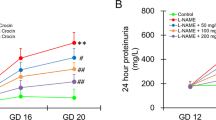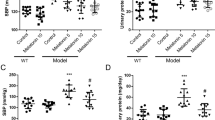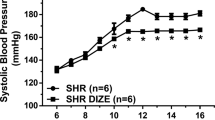Abstract
Gestational hypertension is a high-risk disease for women, and the current treatments have limited efficacies. Here, we aimed to evaluate troxerutin, which is a natural monomer of flavone, in the treatment of gestational hypertension. Pregnant mice with or without pregnancy-induced hypertension (PIH) were treated with troxerutin (20 and 40 mg/kg) or vehicle. Blood pressure and proteinuria were monitored during treatment. The expression of vasodilation converting enzyme (VCE), angiotensin, TNFα, IL-6, IL-1β and IL-10 was measured by enzyme-linked immunosorbent assay (ELISA). Oxidative stress was assessed by measuring the reactive oxygen species (ROS) levels and antioxidant enzyme concentrations. Western blot analysis was used to assess the expression of p-STAT3, STAT3, SHP-1, and RNF6. Troxerutin reduced blood pressure and the expression of VCE, angiotensin, urinary protein and pro-inflammatory cytokines in a dose-dependent manner while increasing the expression of anti-inflammatory cytokines. The levels of ROS were decreased, and the levels of antioxidant enzymes were increased. Troxerutin treatment significantly suppressed STAT3/RNF6 signaling. Overexpression of RNF6 attenuated the effects of troxerutin in ameliorating inflammation and oxidative stress. Our data support the use of troxerutin for reducing gestational hypertension due to the role of troxerutin in reducing inflammation and oxidative stress.
This is a preview of subscription content, access via your institution
Access options
Subscribe to this journal
Receive 12 print issues and online access
$259.00 per year
only $21.58 per issue
Buy this article
- Purchase on Springer Link
- Instant access to full article PDF
Prices may be subject to local taxes which are calculated during checkout





Similar content being viewed by others
References
Theilen LH, Fraser A, Hollingshaus MS, Schliep KC, Varner MW, Smith KR, et al. All-cause and cause-specific mortality after hypertensive disease of pregnancy. Obstet Gynecol. 2016;128:238.
Chen Z, Du J, Shao L, Zheng L, Wu M, Ai M, et al. Prepregnancy body mass index, gestational weight gain, and pregnancy outcomes in China. Int J Gynecol Obstet. 2010;109:41–4.
Folk DM. Hypertensive disorders of pregnancy: overview and current recommendations. J Midwifery Women’s Health. 2018;63:289–300.
Shen M, Smith GN, Rodger M, White RR, Walker MC, Wen SW. Comparison of risk factors and outcomes of gestational hypertension and pre-eclampsia. PLoS ONE. 2017;12:e0175914.
Huang Q, Hu BH, Han XJ, Yang JY, Di XD, Bao JJ, et al. Cyclosporin A ameliorates eclampsia seizure through reducing systemic inflammation in an eclampsia-like rat model. Hypertens Res. 2020;43:263–70.
Clark JL, Zahradka P, Taylor CG. Efficacy of flavonoids in the management of high blood pressure. Nutr Rev. 2015;73:799–822.
de Jesus Romero-Prado MM, Curiel-Beltran JA, Miramontes-Espino MV, Cardona-Munoz EG, Rios-Arellano A, Balam-Salazar LB. Dietary flavonoids added to pharmacological antihypertensive therapy are effective in improving blood pressure. Basic Clin Pharm Toxicol. 2015;117:57–64.
Knekt P, Kumpulainen J, Jarvinen R, Rissanen H, Heliovaara M, Reunanen A, et al. Flavonoid intake and risk of chronic diseases. Am J Clin Nutr. 2002;76:560–8.
Panat NA, Singh BG, Maurya DK, Sandur SK, Ghaskadbi SS. Troxerutin, a natural flavonoid binds to DNA minor groove and enhances cancer cell killing in response to radiation. Chem-Biol Interact. 2016;251:34–44.
Maurya DK, Salvi VP, Nair CKK. Radioprotection of normal tissues in tumor-bearing mice by troxerutin. J Radiat Res. 2004;45:221–8.
Geetha R, Radika MK, Priyadarshini E, Bhavani K, Anuradha CV. Troxerutin reverses fibrotic changes in the myocardium of high-fat high-fructose diet-fed mice. Mol Cell Biochem. 2015;407:263–79.
Raja B, Saranya D, Prabhu R. Role of flavonoid troxerutin on blood pressure, oxidative stress and regulation of lipid metabolism. Front Biosci (Elite Ed). 2019;11:121–9.
Paulin R, Meloche J, Bonnet S. STAT3 signaling in pulmonary arterial hypertension. Jak-Stat. 2012;1:223–33.
Bromberg J, Wang TC. Inflammation and cancer: IL-6 and STAT3 complete the link. Cancer Cell. 2009;15:79–80.
Armstrong DW, Tse MY, O’Tierney-Ginn PF, Wong PG, Ventura NM, Janzen-Pang JJ, et al. Gestational hypertension in atrial natriuretic peptide knockout mice and the developmental origins of salt-sensitivity and cardiac hypertrophy. Regulatory Pept. 2013;186:108–15.
Vinothkumar R, Vinoth Kumar R, Sudha M, Viswanathan P, Balasubramanian T, Nalini N. Modulatory effect of troxerutin on biotransforming enzymes and preneoplasic lesions induced by 1,2-dimethylhydrazine in rat colon carcinogenesis. Exp Mol Pathol. 2014;96:15–26.
Hoseindoost M, Alipour MR, Farajdokht F, Diba R, Bayandor P, Mehri K, et al. Effects of troxerutin on inflammatory cytokines and BDNF levels in male offspring of high-fat diet fed rats. Avicenna J Phytomedicine. 2019;9:597–605.
Zhao X, Wang X. Candesartan targeting of angiotensin II type 1 receptor demonstrates benefits for hypertension in pregnancy via the NF‑κB signaling pathway. Mol Med Rep. 2018;18:705–14.
Sui R, Zang L, Bai Y. Administration of troxerutin and cerebroprotein hydrolysate injection alleviates cerebral ischemia/reperfusion injury by down-regulating caspase molecules. Neuropsychiatr Dis Treat. 2019;15:2345.
Jamali-Raeufy N, Kardgar S, Baluchnejadmojarad T, Roghani M, Goudarzi M. Troxerutin exerts neuroprotection against lipopolysaccharide (LPS) induced oxidative stress and neuroinflammation through targeting SIRT1/SIRT3 signaling pathway. Metab Brain Dis. 2019;34:1505–13.
Ji JZ, Elyaman W, Yip HK, Lee VW, Yick LW, Hugon J, et al. CNTF promotes survival of retinal ganglion cells after induction of ocular hypertension in rats: the possible involvement of STAT3 pathway. Eur J Neurosci. 2004;19:265–72.
Zhang Z, Yang X, Zhang L, Duan Z, Jia L, Wang P, et al. Decreased expression and activation of Stat3 in severe preeclampsia. J Mol Histol. 2015;46:205–19.
Hodge DR, Hurt EM, Farrar WL. The role of IL-6 and STAT3 in inflammation and cancer. Eur J Cancer. 2005;41:2502–12.
Huang ZM, Cai Y, Yang CC, Chen Z, Sun H, Xu Y, et al. Knockdown of RNF6 inhibits gastric cancer cell growth by suppressing STAT3 signaling. Oncotargets Ther. 2018;11:6579–86.
Subastri A, Harikrishna K, Sureshkumar M, Alshammari GM, Aristatile B, Thirunavukkarasu C. Effect of troxerutin on 2-aminoanthracene and DNA interaction and its anti-mutagenic property. Biomed Pharmacother. 2017;88:325–34.
Author information
Authors and Affiliations
Corresponding author
Ethics declarations
Conflict of interest
The authors declare that they have no conflict of interest.
Additional information
Publisher’s note Springer Nature remains neutral with regard to jurisdictional claims in published maps and institutional affiliations.
Supplementary information
Rights and permissions
About this article
Cite this article
Li, Y., Yang, X., Sun, Q. et al. The bioflavonoid troxerutin prevents gestational hypertension in mice by inhibiting STAT3 signaling. Hypertens Res 44, 399–406 (2021). https://doi.org/10.1038/s41440-020-00568-z
Received:
Revised:
Accepted:
Published:
Issue Date:
DOI: https://doi.org/10.1038/s41440-020-00568-z
Keywords
This article is cited by
-
Recent advances in anti-inflammatory active components and action mechanisms of natural medicines
Inflammopharmacology (2023)



